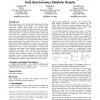24 search results - page 1 / 5 » Reduction techniques for synchronous dataflow graphs |
DAC
2009
ACM
13 years 8 months ago
2009
ACM
The Synchronous Dataflow (SDF) model of computation is popular for modelling the timing behaviour of real-time embedded hardware and software systems and applications. It is an es...
ISSS
1999
IEEE
13 years 9 months ago
1999
IEEE
Synchronous Dataflow, a subset of dataflow, has proven to be a good match for specifying DSP programs. Because of the limited amount of memory in embedded DSPs, a key problem duri...
CODES
2005
IEEE
13 years 10 months ago
2005
IEEE
This paper proposes a new efficient buffer management technique called shift buffering for automatic code synthesis from synchronous dataflow graphs (SDF). Two previous buffer man...
CODES
2010
IEEE
13 years 2 months ago
2010
IEEE
Synchronous Dataflow (SDF) is a powerful analysis tool for regular, cyclic, parallel task graphs. The behaviour of SDF graphs however is static and therefore not always able to ac...
TC
2008
13 years 4 months ago
2008
Multimedia applications usually have throughput constraints. An implementation must meet these constraints, while it minimizes resource usage and energy consumption. The compute in...

